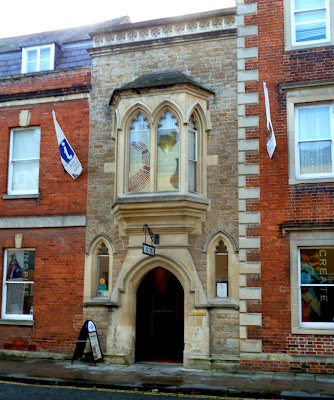Devizes Museum, seen to the right, holds a series of Saturday afternoon talks throughout the year, and on Saturday I listened to a talk, with some wonderful illustrations, about Anglo-Saxon art, and it's changes from the time the Romans left Britain in ca 430AD, until the coming of William the Conqueror in 1066. The speaker was Dr Leslie Webster, the ex Keeper of Medieval Antiquities, curating the Anglo-Saxon, Viking and Celtic and Continental early medieval collections at the British Museum. The photo shows the entrance to the museum in Long Street, which holds many finds from the local area, including Avebury and Stonehenge stone circles. The new visitor centre at Stonehenge will soon display some of the gold finds from our museum. The "Blue Plaque" below gives the dates of the museum`s foundation and it opening in 1847.
The Blue Plaque at the entrance to the museum.
Dr Webster accompanied her talk with many lovely photographs of finds from the principal Anglo-Saxon hoards at Sutton Hoo and in Staffordshire. She spoke in detail about the complexity and origins of the designs, the use of animal shapes, and the Anglo-Saxon love of riddles.
The military fitting above, crafted in gold and garnet cloisonne, is part of the Staffordshire hoard, the largest collection of Anglo-Saxon gold and silver metalwork ever found anywhere in the world. It was found in a field near the village of Hammerwich, near Lichfield in Staffordshire, by a man out metal detecting on July 5th 2009, and consists of more than 3,500 items, nearly all martial or warlike in character. The finder and the landowner shared the cash reward from the find, which left both men £1.5million richer.
The hoard consists of 5.094 kilos of gold, 1.442 kilos of silver, and there is nothing comparable in terms of content and quantity in the UK or mainland Europe.
Belt buckle crafted in gold and niello, from the Sutton Hoo ship burial.
Sutton Hoo, near Woodbridge in Suffolk, is the site of two 6th and early 7th century cemeteries. One contained an undisturbed ship-burial including a wealth of Anglo-Saxon artefacts of art historical and archeological significance, now housed in the British Museum in London.
The ship burial probably dating from the early 7th century, was excavated in 1939. It is thought to contain the body of Raedwald, the ruler of the East Angles, who held power over the English people, and played an part in the establishment of Christian rulership in England.
A very interesting talk, with some wonderful photos.




No comments:
Post a Comment